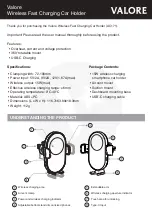
Planning
Take a moment to plan for the sensor’s successful operation and
optimal communication with other system components.
Remove the sensor from its packaging and place it under a
bright light to provide the required startup charge. To quickly
ensure the sensor energy storage is fully charged, insert a
CR2032 battery for 5 minutes.
▪
Ensure the location provides consistent and adequate light
▪
Install with the appropriate lens for the required coverage
▪
Avoid installed near ceiling fan or hanging fixtures
▪
Consider the area’s traffic patterns and principal use, for
example, walking, working, lounging or sleeping
▪
Provide a minimum clearance of 4 ft. (1.2 m) away from heat
sources, light bulbs, forced air, or ventilation systems
▪
Consider the construction materials (such as metal) in the
space and obstacles that may interfere with RF signals
Sensor Range
A single occupancy sensor provides sufficient coverage for most
applications. For some applications, multiple sensors may be
required to provide complete coverage.
Coverage Diagrams
To provide coverage for very high ceilings, a wall sensor can be
incorporating in the plan for complete coverage.
Installing
The occupancy sensor can be mounted on most ceilings with
the provided screws, or mounted on dropped ceilings, using the
provided wire bracket.
NOTE: It may be easier to link the sensor before it is mounted
on the ceiling. Refer to the “Linking” section.
1. Decide where you want to install the occupancy sensor.
Tip: For visual alignment, orient the sensor parallel to one of
the walls.
2. Remove the mounting plate from the sensor.
3. Decide which of the two installation options is appropriate.
A. Screw Mounting Plate to the Ceiling
i. Hold the mounting plate in place on the ceiling and
use a pencil to lightly mark two small dots for the
screw drill points.
ii. Drill two holes with a 3/16” drill bit and insert
the wall anchors.
iii.
Insert the first screw
loosely and level the
mounting plate.
iv. Insert the second screw
and then hand-tighten
the first screw.
B. Mount Using the Wire Bracket
i. Remove the ceiling tile where you want to
mount the sensor.
ii. Place the mounting plate squarely on the ceiling tile
and use the wire to mark two points for the holes.
iii. Punch two small holes
through the ceiling tile at
the marked points.
iv. Insert the wire bracket
through the two holes in
the mounting plate.
Make sure the ends are
roughly even.
v. Feed the wires through the
holes in the ceiling tile.
vi. On the front of the ceiling
tile, flatten the wire bracket
so it is snug against the
mounting plate.
estimated time: 20 minutes
Occupancy Sensor – Ceiling Mounted • Installation Guide
Page 2





















